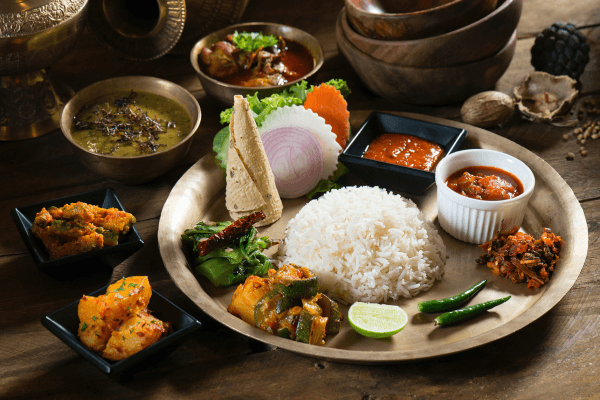All the three diets – Ayurvedic, yogic, and pranic, focus on the mind, body, and spirit to promote holistic well-being.
In this blog, I will explain the fundamental interrelationship between ayurveda, pranic, and yogic diets – a path towards holistic well-being. These traditional food concepts provide special insights into attaining harmony and vitality in a world where people are becoming more and more aware of the significance of nourishing the body as well as the soul.
Let us explore the power of pranic foods, the wisdom of Ayurveda, and the spiritual nourishment of yogic nutrition.
What is Ayurveda?
Ayurveda is a traditional medical system that covers a wide range of topics related to wellness, illness prevention, and overall health.
The foundation of ayurveda is the idea that everything in the universe and the surrounding environment are interconnected.
To enhance general well-being, it aims to achieve harmony and balance among the body, mind, and spirit.
The ayurvedic diet is a long-standing eating regimen based on the ideas of ayurveda. The goal of this holistic approach to health and wellbeing is to prevent illness and create general equilibrium inside the body by balancing the three doshas (pitta, kapha, and vata).
Important principles of the Ayurvedic diet
- There is no one-size-fits-all ayurvedic diet; instead, there are specialised diets for each individual.
- Food is divided into six tastes according to ayurveda: sweet, sour, salty, bitter, pungent, and astringent.
- Eating by the seasons improves digestion and general health by bringing the body into harmony with the environment’s natural cycles.
- Ayurveda places a strong emphasis on maintaining a strong digestive fire, or agni.
- Food combinations are encouraged or discouraged based on their impact on digestion.
- Ayurvedic cooking incorporates a variety of herbs and spices that are used for their medicinal properties.
- It encourages mindful eating and balancing individual doshas.
- It encourages mindful eating and balancing individual doshas.
Prana: What is it?
The Sanskrit word for life or breath is prana. Similar to “qi” (or “chi”) in conventional Chinese medicine, prana is the life force or vital energy according to Hinduism (TCM).
Prana is seen as a universal, cosmic energy in the Hindu practice of yoga. When prana is present within you, it gives life; when it departs from the body, it causes death.
The fundamental idea underlying pranic foods is how a certain food’s energy impacts your life force.
Pranic food: What is it?
Pranic healing, which is a completely separate idea, should not be confused with pranic food. A form of energy therapy known as pranic healing is based on the idea that the body is capable of mending itself and that energy can be employed to hasten the healing process.
Instead, the idea of pranic meals has a lot in common with the yogic diets that are discussed in Ayurvedic writings. Traditional Indian medicine known as Ayurveda approaches health holistically, including diet.
There are some similarities between the Ayurvedic diet and the concept of pranic foods, especially in their emphasis on energy and balance in the body. The concept of pranic foods is not specifically mentioned in Ayurvedic texts, but it is consistent with the overall concepts of energy in traditional Indian practices, even though Ayurveda offers a comprehensive system of traditional medicine.
Based on how they impact your prana or energy, pranic meals are divided into three groups.
Positivity-promoting food
- The life powers of a person are said to be sparked by positive pranic meals. Fresh, whole, minimally processed, domestically sourced, and organic foods fall under this category.
- Healthy meals have a moderate flavour. They should not be consumed in excess. Ash gourd, honey, coconut, millet, nuts and seeds, fresh fruits (both fresh and dried), fresh vegetables, sprouted mung, beans, and lentils are some of these foods.
- Healthy meals have a moderate flavour. They should not be consumed in excess. Ash gourd, honey, coconut, millet, nuts and seeds, fresh fruits (both fresh and dried), fresh vegetables, sprouted mung, beans, and lentils are some of these foods.
Negative pranic foods
- Positive pranic foods are said to rob you of essential energy. These include stimulants, which provide you with immediate energy but may also cause a crash later.
- It is believed that over-powering flavourful foods, such as those that are extremely salty, spicy, sour, or pungent, will damage your prana. The following foods are listed by many pranic food practitioners as having a bad impact on prana: onion, garlic, asafoetida, coffee, tea, chilli, aubergine (brinjal), stimulants like caffeine, and intoxicants like alcohol.
- Some sources include meats, eggs, fish, and poultry as negative pranic food, while others say that as long as food is prepared properly and eaten in moderation, these items are fine.
- Some sources include meats, eggs, fish, and poultry as negative pranic food, while others say that as long as food is prepared properly and eaten in moderation, these items are fine.
Pranic neutral foods
- Foods that are neutral in terms of prana neither boost nor diminish it. However, they could make you feel a little lethargic. Tomatoes and potatoes are neutral pranic foods.
- Foods that are neutral in terms of prana neither boost nor diminish it. However, they could make you feel a little lethargic. Tomatoes and potatoes are neutral pranic foods.
How pranic foods relate to the ayurvedic diet ?
Energy and vitality
- The importance of energy, or life force, within the body, is recognised by both ayurveda and pranic foods.
- This vital energy is called prana in ayurveda, and the goal of the ayurvedic diet is to balance doshas and improve general health. Similar to this, pranic foods emphasise the life force found in particular foods and how it affects a person’s energy levels.
Food categorisation
- Foods are categorised according to how they affect energy in both methods. Foods are categorised by ayurveda based on doshas (vata, pitta, and kapha).
- Whereas foods classified as pranic are classified as positive, negative, or neutral based on how they affect prana.
- Both highlight the belief, that particular foods can either improve or deplete energy.
Avoidance of specific foods
- To preserve harmony, ayurveda prescribes avoiding specific foods based on a person’s dosha.
- Similar to this, foods high in flavour and stimulants are categorised as negative pranic foods because they have the potential to deplete energy.
Holistic approach to health
- A holistic approach to health includes both pranic foods and the Ayurvedic diet.
- They take into account not only the mental and spiritual dimensions of well-being but also the physical well-being.
In particular, Ayurveda places a strong emphasis on individualised treatment and matching a person’s lifestyle to their constitution and medical needs.
Comparing yogic diet concepts to pranic foods
The originator of the phrase “pranic foods” is unknown, and neither the idea nor the diet has a recorded history. Although pranic foods are not mentioned in Ayurveda, yoga, or any ancient Indian texts, the idea is consistent with the yogic and ayurvedic viewpoints on nutrition.
Ayurveda is an effective medical system that advises you to eat according to your constitution, way of life, and health requirements. It does not forbid meats or discourage the consumption of onions or garlic.
The Indian subcontinent’s ascetic monks and yoga practitioners, often known as yogis, adhere to a set of dietary rules known as the yogic diet principles.
The yogic diet is mentioned in scriptures from over 5,000 years ago. Yoga diets can be classified as Sattvic, Rajasic, or Tamasic.
Sattvic meal – Foods that have been barely cooked and minimally spiced are the closest to their original state. This eating plan is said to improve focus and serenity. Anyone seeking a tranquil and peaceful living would benefit the most from it.
Rajasic meal – This diet enables foods with strong flavours including onion, garlic, asafoetida, and other bitter, salty, spicy, hot, and pungent flavours. This diet is exciting and arouses a range of emotions, making it best suited for athletes, leaders, artists, etc.
Tamasic meal – This diet consists of overcooked or undercooked foods, stale, infected, fermented, fried, stimulants, and alcohol. This eating style is thought to be unhealthy and promotes weakness and exhaustion.
Positive pranic foods and the sattvic diet share many parallels with negative pranic foods and the rajasic and tamasic diets. Pranic foods are not documented or mentioned in historical sources, although their fundamental ideas may have their roots in antiquity.
The Ayurvedic diet is not a one-size-fits-all plan; rather, it takes into account each person’s unique constitution or dosha, which includes vata, pitta, and kapha. It also suggests eating primarily sattvic food.
Common concepts of all 3 diets
Mind-body connection – Each of the three dietary strategies acknowledges the close relationship between physical and mental health.
Customised diets – Although Ayurveda designs diets according to the dosha constitution, yogi diets and pranic foods also place a strong emphasis on customised diets for energising the body and fostering spiritual development.
Plant-based emphasis – All three strategies place a strong emphasis on plant-based, whole foods, emphasising the value of a diet abundant in fruits, vegetables, and nuts.
The Yogi diet’s emphasis on purity and Ayurveda’s mindful eating practises both highlight the need to make deliberate and mindful food choices.
Through investigating the interrelationships among the yogi diet, pranic food, and ayurveda, we all can incorporate the knowledge of these traditions into our eating practices to encourage a holistic and healthy approach to both bodily and spiritual well-being.
Conclusion
A pearl of ancient wisdom connected to a harmonious pattern for overall well-being is found in the fusion of pranic, yogic, and ayurvedic diets. Despite their differences, these food ideologies are based on the idea of mindful eating, which emphasises the interdependent relationship between the body, mind, and spirit.
The purity-seeking yogi diet is enhanced by the dosha-balancing wisdom of ayurveda, and vigour is added by the spiritual essence of pranic foods. Collectively, they depict a state of conscious eating in which nourishment serves as a medium for harmony and spiritual development.
Let us remember, as we negotiate the complex interplay between these customs, that the decisions we make at the dining table have an impact that extends well beyond our nutritional needs and impacts the balance of our entire existence.
I hope that this blog encourages a conscious, deliberate approach to eating, leading to a more complete and enlightened journey to well-being.
Varsha M,
Senior Clinical Dietitian, Simplyweight













